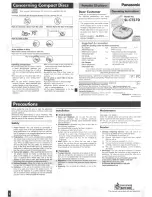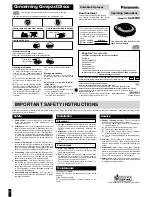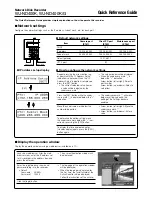
25
•
Push the exhaust nozzles (4) under the arm (G)
till both switching plungers (I) are balanced to the
slotted holes (H). (Fig.8.1)
•
Insert the switching plungers (1) into the slotted
holes
•
Fasten the exhaust hood (4) on the jointing table
with the knurled screw (K) (Fig.8.2)
•
Push the knife cover over the exhaust nozzles
Planer axle guard (Fig. 9)
Height adjustment is done with the clamping handle
(J). After loosening the clamp
(K)
, the knife cover can
be pushed to the side and the planer adjusted to the
correct width. After adjusting, close the clamp.
Surfacing:
The amount of chip removal is set by means
(Fig.
8.2, L)
of the scale
(M)
on the front side of the table
top (
N)
. The best surface is obtained at a planing
depth between 0.5 and 1.5 mm.
Warning:
The part of the cutter block not used must by covered
by the guard. Working position is in front of the ma-
chine at the side of the infeed table. Put the fingers
of both hands on top of the work piece. Do not hold
the work piece edges.
The work pieces to be planed must lie firmly on the
table so they can be guided safely. For shorter work
pieces use a feeding tube or the guide handle.
Thicknessing:
• Following the scale and using the handle
(O)
on the
spindle, set the thicknessing table to the desired
height. 1 rotation = 3 mm.
• Slide narrow wood to the centre of the thickness
table.
For thickness planing and also jointing the use of
spray lubrication or compound. After a long period
of use, or when planing humid wood, it can happen
that the work piece is not further pulled in.
Warning:
In case of a defect, switch off the machine at once.
Do not remove any chips or splinters from the tables
while the machine is running. Work pieces below 250
mm length may not be planed.
Changing the knives (Fig. 11)
• Put the main switch of the machine to OFF position.
• Pull the power supply plug from the socket.
• Block the cutter block guard in the lifted position.
•
Soulevez le bras (G) de la protection de l’arbre
de dégau, de sorte que le trou oblong (H) soit
exposé.
•
Faites glisser le manchon d’aspiration (4) sous
le bras (G) jusqu’à ce que le poussoir de com-
mande (I) et le trou oblong (H) soient alignés
(H) (Fig. 8.1).
•
Poussez le poussoir de commande (l) dans le
trou oblong.
•
À l’aide de la vis moletée (K), fixez la hotte aspi
-
rante (4) sur la table de dégau (Fig.8.2).
•
Faites glisser le protège-lame sur le manchon
d’aspiration.
Protection de l’arbre de rabot (Fig. 9)
Le réglage en hauteur se fait avec la poignée de
blocage (J). Après desserrage du collier de serrage
(K)
la protection du couteau peut être poussée sur le
côté pour permettre le réglage correct de la largeur
du rabot. Après le réglage, refermer le collier de
serrage.
Dégauchisser:
La profondeur de rabotage est réglée par la poignée
(Fig. 8.2, L)
monté sur la face de la table (
N
, à l’aide
d’une échelle. La meilleure
(M)
surface s’obtient avec
une profondeur de rabotage entre 0,5 et 1,5 mm.
Attention:
Le dispositif de protection de l’arbre de rabotage doit
recouvrir la partie non utilisée de l’arbre. La position
de travaille est devant la machine à côté d’alimenta
-
tion de bois. Mettre les doigts de deux mains sur la
pièce à travailler. Ne pas toucher les arêtes du bois.
Seulement traiter des pièces de bois reposant fermé
-
ment sur la table et pouvant être guidées de manière
sûre.
Pour des pièces à usiner courtes, utiliser un
tiroir d’alimentation ou la poignée de guidage.
Raboter:
•
Régler la table de rabotage à la hauteur désirée à
l’aide de la poignée
(O)
sur la broche, et l’échelle.
1 révolution = 3 mm.
•
Introduire du bois étroit au centre de la table de
rabotage.
Pour le rabotage d’épaisseur comme pour le
dressage il est recommandé d’utiliser un spray de
glissement ou une pâte.
Après une période d’usage
prolongée, ou en traitant le bois humide, l’avance du
bois peut être bloquée.
Avertissement:
En cas d’une panne, mettre la machine hors ser
-
vice immédiatement. Ne pas enlever des copeaux
pendant que la machine est en marche. Il est inter-
dit de raboter des pièces de bois d’une dimension
inférieure à 25 cm.
Remplacement des fers de rabot
(Fig. 11)
•
Mettre l'interrupteur à la position «Arrêt».
•
Débrancher la prise d’alimentation.
•
Bloquer la protection de l'arbre de rabotage dans
sa position la plus haute.
Содержание 5902206901
Страница 2: ......
Страница 35: ...35 IT FIN HU...
Страница 67: ...67 CZ SK SLO...
Страница 95: ...95 NO SE EST...
Страница 123: ...123 LIT LAT DK...
Страница 151: ......
Страница 152: ......
Страница 153: ......
















































